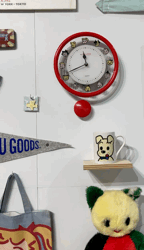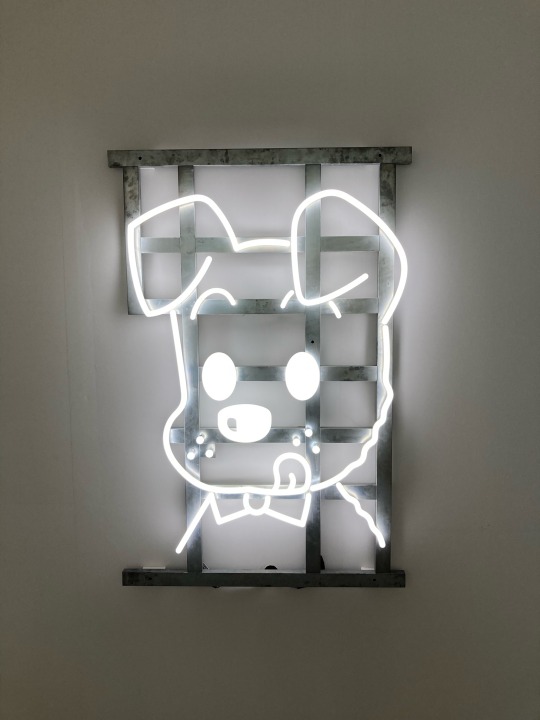#osamu harada
Text


"ZAZIE dans le métro" illustrated by Osamu Harada
原田治 画「地下鉄のザジ」🇫🇷
1988年
57 notes
·
View notes
Text



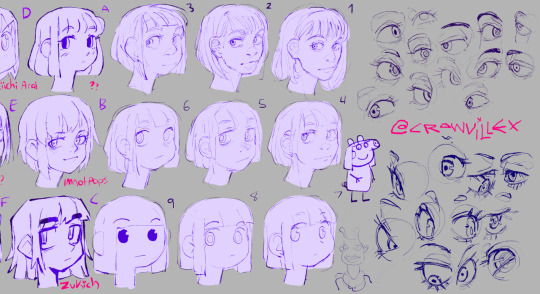
Various artist face style studies 😀✍️
Mostly other artists ik and some iconic ones too but these were real fun to do and see how everyone stylized the same facial features & proportions along with linework, idt I studied anyone again apart from one in the future though... 👀
#digital art#digital drawing#doodle#painting practice#psg#pswg#inio asano#danny antonucci#bkub okawa#takehito harada#naoko takeuchi#toru nakayama#bryan lee o'malley#katsuhiro otomo#style study#style practice#keiichi arawi#osamu tezuka
64 notes
·
View notes
Text
All the victims listed in the Genocide Jack file.
Likely because English takes more space, the English version did not include all of the names. I’ll mark those ones with a star. They also mixed up first names and last names a lot so mine will all follow the typical format: [First] [Last] ([Last Kanji] [First Kanji])
Ken Harada (原田 剣)
Tetsuhiro Honda (本多 鉄広)
Gaku Shouji (庄司 岳)
Issei Kanno (菅野 一聖)
Takeshi Yoshida (吉田 威士)
Tarou Komatsuna (小松奈 太郎)
Takefumi Gouno (郷野 武文)
Youji Onda (恩田 洋治) ☆
Erio Kishida (岸田 絵李夫) ☆
Osamu Tsuji (辻 修) ☆
Naohisa Uchida (内田 直久)
Masamune Takashi (貴志 正宗)
Yuuto Yumejima (夢島 由人)
Japanese books are read right to left and the first victim is listed as 32 (when we know the first victim was her age), so I assume this list starts at 37 (her victim count) and goes down to 25.
#danganronpa#genocide jack#genocide jill#genocider syo#genocider sho#danganronpa trigger happy havoc
20 notes
·
View notes
Text
'70s Harajuku (Part 2)
The Harajuku district in Shibuya has gained international acclaim as a hub of Tokyo's youth culture and fashion scene. Its streets are lined with cafes, boutiques, and well-known fast fashion stores, drawing a constant stream of tourists, fashionistas, and teenagers. However, before the arrival of billionaire retailers, foreigners, and media attention, this area's early inhabitants were the ones who truly shaped its unique character.
'70s Harajuku (Part 1)
There's been a few books written about Harajuku and its culture in the '70s. Famed photographer Shinpei Asai wrote "Central Apartments Monogatari" (Central Apartments Tale), published in 2002. Futoshi Kimizuka interviewed some creative professionals who had offices in the building for 2004's "Central Apartments no asobi" (Walking through Central Apartments). Yasuko Takahashi, Japan's first stylist, wrote extensively about her experience working and playing in the neighborhood during that era in "Omotesando no Yakko-san" (Yakko-san from Omotesando, 2012) and "Toki no kakeru Yakko-san" (Yakko-san Who Leapt Through Time, 2015). In 2019, Non Nakamura, who started out as Yakko-san's assistant, compiled photographs and essays from influential figures of the time in "70s Harajuku Genfuukei."
This same Non Nakamura contributed what I consider to be some of the most insightful and readily available essays on this period through her "20th Century Girl" serialization in Mononcle. These essays are accessible for free on their website (in Japanese, though Google Translate provides a decent translation). Nakamura's series chronicles the culture of the 1970s in Harajuku and the broader oshare influences of that decade.
The first essay discusses how she owes her fateful meeting with Yakko-san to rock 'n' roll. Nakamura was a teen during the folk music era when rockstars had long hair, worn-out T-shirts, and bell-bottom denim. She wasn't particularly attracted to this type of fashion, so when she first saw glamorous-looking David Bowie in a magazine, she instantly fell in love with him. Her other passion was the band Carols. She passed by a poster of them, with their regent hairstyles, motorcycles, and leather jackets, on her way to her part-time job in Shinjuku and was remarkably attracted to them. After work, she ran to the record store and bought their then-just-released first single, "Louisiana." When she got home and dropped the needle on the record, the sound of rock 'n' roll took over her body, and she was utterly fascinated with the band. Soon after, she got a boyfriend who followed the regent hairstyle/leather jacket/motorcycle trend of the time.
Nakamura hated studying and wasn't interested in school clubs and activities. She'd fulfill her curiosity about the world by reading the dressmaking magazine Fukusou and admiring the avant-garde professionals that worked in it, such as the photographers (Saku Sawatari, Daitomo Yoshida, Osamu Nagahama), the illustrators (Ayumu Ohashi, Teruhiko Yumura, Yosuke Kawamura, Osamu Harada, Tamie Okumura), the models (Risa Akigawa, Brenda, Ichizo Koizumi), and the writers (Takeshi Matsuyama and Ken Sunayama).
One day, Yasuko Takahashi, aka Yakko-san, started a serialization in Fukusou. In her inaugural essay, she wrote that if she were a teen, she'd probably be chasing her rock 'n' roll dreams and dating a rocker dude her mom disapproved of. These words resonated deeply with Nakamura, who found school tiresome, yearned for an artsy and glamorous world, adored Carol and Bowie, and was dating a delinquent high school dropout who didn't earn her mother's favor. She felt seen and understood.
In her column, Yakko-san published plenty of photos of her daily life. To Nakamura's surprise, she was friends with the guys from Carol and also worked as a stylist for David Bowie. In the 17-year-old girl's eyes, she was the most incredible woman alive.
As she recounts in her second essay, her deep relationship with the Fukuso magazine team started a few months before Yakko-san's inaugural column in the October '73 issue. One day during the spring of her senior year, she felt compelled to write a letter to the magazine professing her love for it. She dreamed of being an illustrator, so she included a bunch of her doodles. To her surprise, the editorial team called her home a few months later and invited her to their office.
After school, she changed from her uniform to her favorite clothes (which included a shirt she bought from a London import shop in the basement of Central Apartments and a gingham skirt she made inspired by MiLK) and eagerly made her way to the meeting. The editors inquired about her clothing and life, and their comment, "I sensed something in you that was not Yojohan-ish," stuck with her.
To understand the context of this comment, we must go back in time to the folk music fever of the '70s, when yojohan (4 tatamis and a mat) folk was at its peak. Yojohan referred to small rooms where impoverished university students lived, often idealized in songs about young love and melancholy that dominated the charts. Nakamura was happy with the comment because, indeed, she didn't like the poor and humid vibe of said songs. She was drawn instead to dreamy pop and rock.
The teen girl left the magazine's office that day with an invite to publish a double-spread page in the June issue, full of her illustrations and thoughts. It was quite an achievement for her.
Encouraged by this experience, she didn't hesitate to write Yakklp-san a letter. And to her astonishment, Yakko-san replied! Before she knew it, they had become penpals and engaged in lengthy phone conversations. Thus began a profound friendship between a 17-year-old high school student and a 34-year-old stylist at the pinnacle of her career.
Funnily enough, Yakko-san feared meeting Nakamura and disappointing her. To the 17-year-old, it was amusing that a grown woman who organized Japan's top designer Kansai Yamamoto's show in London Fashion Week and had the initiative to collaborate with world-famous figures such as T-Rex and David Bowie would be intimidated by her.
But, as she recounts in her third essay, they finally met. First, a quick 10-minute meeting in a Shibuya coffee shop. And then a proper encounter at the renowned Leon, where she also met other cool people she used to see in the magazines. Soon after, she became a frequent visitor to Yakko-san's small apartment in Harajuku.
Initially, she was taken aback by the apartment's minimalist and compact layout, as well as Yakko's sparse possessions. Yet, within the broader context, it made sense that a trend-savvy individual in 1973 lived this way. It was the year of the Oil Shock, the first post-war recession and frugality was in vogue. Books like "Jonathan Livingston Seagull," an anti-materialism allegory, and Alicia Bay Laurel's "Back to the Earth" became bestsellers, reflecting the shift towards a more modest lifestyle.
Amid the growing popularity of the back-to-the-land movement in the United States, minimalism and healthy living gained global momentum. It was Yakko-san who first introduced Nakamura to these ideas.
Through Yakko, Nakamura also learned about "natural food," a relatively unfamiliar concept in Japan at the time. While a foreign concept to most, natural food was all the rage in the vibrant neighborhood of Harajuku, and locals bought it from the market in the basement of the luxury Co-Op Olympia condo. Additionally, a delivery service offered pesticide-free vegetables, spearheaded by a former Leon patron who had forsaken a successful creative career to explore his passion for sustainable farming. Through these encounters, young Nakamura began to comprehend that life presented various paths, and fashion encompassed not only clothing but also a holistic lifestyle, including food and living habits.
The fourth installment focuses on Sayoko Yamaguchi, one of Japan's top models of the '70s, who had worldwide success and shared a close relationship with Yakko-san. Nakamura observed that during that era, the most prominent models were of mixed heritage (haafus), characterized by big eyes, long eyelashes, and wavy hair. Notably, Lisa Akigawa was one of the most renowned among them. In contrast, Yamaguchi stood apart with her almond-shaped eyes and black bob haircut. Her unique style served as an inspiration for many Japanese girls, fostering their self-confidence. Her signature eyeliner makeup and haircut were emulated by numerous admirers. While Yamaguchi enjoyed global fame at international fashion weeks, she became a familiar face to the Japanese public through her Shiseido commercials. She was among the numerous icons in fashion and culture closely connected to Yakko-san.

During the 1970s, Sayoko Yamaguchi was one of the faces of Shiseido cosmetics.
Another notable figure in this circle was the director Juzo Itami, whose tight relationship with Yakko-san was evident in his introduction to her first book, "Aisatsu no Nai no Nagadenwa" (Long Phone Conversation with no Greeting), published in 1976. This title offered one of the first comprehensive examinations of the "stylist" profession, which was relatively obscure in Japan then.
In the fifth essay, Nakamura writes how she found out about the profession through an article at AnAn, which briefly described a stylist as "people who lease clothes for fashion shoots, run around Harajuku with large bags, line the soles of model's shoes with duct tape, coordinate clothes, and attend shoots."
As she discovered through her work with Yakko-san, stylists do way more than that. And that was also what Itami tried to convey in the introduction to Yakko's book:
"I want to introduce my friend, Yasuko Takahashi. She is a first-class stylist. When making fashion editorials or commercials, a stylist can materialize a suitable house, the right interior design, or a place just like the one you're looking for out of thin air. At the same time, they also find props that are suitable for the location and source costumes. Depending on the situation, they will interact with the models and even advise on hair and make-up, so they must be genuinely knowledgeable. Collaborating with Yakko is, without exaggeration, a heavenly experience for me. She is a consummate professional. Once upon a time, when she couldn't find a suitable location, she wandered through town all night, shedding tears of frustration until she eventually discovered one. I mean, she's persistent. Her tenacity isn't limited to her professional life; in her case, she's unwavering in allowing her creativity to roam freely."
Yakko and Itami first met after being introduced by famed photographer Shinpei Asai, who had his office at Harajuku Central Apartments. The three of them worked together on a serialization Itami had at Shūkan Bunshun magazine in the sixties, which had Asai in charge of the photography and Takahashi doing the styling.
Takahashi was impressed by Itami's sensitivity to trends on a global scale. When she went to New York, he told her to buy a Yellow Pages-sized book, "Whole Earth Catalog," which inspired his weekly column. As covered here, "Whole Earth Catalog" was highly influential among Japanese media and creative types in the late 60s and early 70s, molding much of Japan's fashion culture.
But back to Non Nakamura's column, stylist was a novel occupation. She notes that stylists became highly sought after in the 80s, with the effects of the D.C. brand boom and the bubble economy. A diverse range of stylist roles emerged, including magazine stylists, advertising stylists, men's fashion stylists, and even specialists in props and food styling, each requiring unique skills and expertise. But back then, when Yakko-san was one of the few professionals doing this job, a stylist was in charge of everything, from the models and shooting locations to the costumes, dishes, houseplants, furniture, or anything else the shoot may need.
One day, Yakko asked Non to work as her assistant on a Noriyaki Yokosuka shoot. She promptly accepted, even though she had no idea who the photographer was. However, when she mentioned him to the boys in her design school, they were impressed and told her that he was the one who photographed Sayoko Yamaguchi's Shiseido posters, as well as doing the Parco ads. Parco, the Shibuya fashion building, had the buzziest campaigns in the country under Eiko Ishioka's art direction.
When she got to the shoot, the photographer asked her to get some poppy flowers. Faced with challenges in finding these specific flowers, Non embarked on a frantic quest, purchasing as many as she could to meet the photographer's expectations. However, to her astonishment, the photographer didn't even glance at the flowers. That's when she realized that being a stylist was a tough job.
David Bowie was the theme of two installments of the column. Yakko-san introduced him to legendary Japanese designer Kansai Yamamoto, who was behind some of his most legendary costumes, and they established a close working relationship in the 1970s. During her tenure as Yakko's assistant, Non had the opportunity to meet Bowie in a 1977 photoshoot in Harajuku. One of the photographs from that session, captured by Masayoshi Sukita, ultimately was used as the cover of Bowie's 12th studio album, "Heroes."

The cover of Bowie's 12th studio album, "Heroes," was shot in Harajuku. Yakko-san was the stylist.
She also dedicated a chapter to another one of her idols, Eikichi Yazawa, whom she met just a few weeks after Carol's farewell concert as he prepared to make his solo debut. She recounts that his charm so enchanted her that she realized she didn't actually love her boyfriend at the time, breaking up with him shortly after.
Nakamura watched Carol's final concert twice. Along with the rest of the country, she followed the telecast, aired a few days later. As she recounts, she and Yakko-san were working in Harajuku on a Saturday afternoon when the stylist took a look at her watch, said, "oh, it's starting soon," and rushed to a design office at Central Apartment that had a TV (minimalist Yakko-san didn't have one at her place).
But she also was one of the lucky few who actually were at the proper concert in Hibya Open Air, which she attended all dressed up in clothes from the trendy Creamy Soda boutique in Harajuku (the owner was notoriously close to Carol's members). Infected by the feral atmosphere, she ended up in the front row and even tried to invade the stage. She succeeded in getting her right foot in before being kicked out by the security guard. But here's a twist: the security was also a regular at Harajuku's Leon coffee shop.
In the 1970s, the hippiest motorcycling gang in Tokyo was The Cools. They were known for their cool styles, hung out with models and celebrities, and were always at Leon. Of course, like all of Japan's young bad boys, they were also big Carol fans. And they actually became close to the members. For their final show, the band wanted to mimic the Rolling Stones -- which had the Hell's Angels as security -- and they invited The Cools to escort them and guard the stage.
After Carols disbanded, the Cools were actually hired by a major record label and became a proper rock band.
In the 1970s, Harajuku remained a hidden gem, undiscovered by the masses. Yet, this small district nestled within bustling Shibuya played an integral role in the histories of the most extraordinary individuals. As the rest of the country caught on, they sought a taste of Harajuku's uniqueness, propelling it into the phenomenon it has become today.
#carol#the cools#70s japan#70s japanese music#harajuku#70s harajuku#non nakamura#sayoko yamaguchi#david bowie
6 notes
·
View notes
Photo

: : Osamu Harada Finding “KAWAII“ : #原田治展 #懐かしい気持ちになった #休日 #岡山シティミュージアム #illustration#アート#museum#museo#art#design#オサムグッズ https://www.instagram.com/p/Cl8eYYVPNPj/?igshid=NGJjMDIxMWI=
6 notes
·
View notes
Text
Urusei Yatsura Season 2 Episode 39: Shutaro - Jinxed Morning
Written by Yū Yamamoto, Hiroyuki Hoshiyama, Akira Nakahara & Masaki Tsuji
Storyboard by Tameo Kohanawa, Masuji Harada & Tamiko Kojima
Directed by Mamoru Oshii, Keiji Hayakawa, Osamu Sekita & Tamiko Kojima
Animation directed by Asami Endo, Hayao Nobe & Noboru Furuse

0 notes
Text
助詞「の」の使い方
The Use of the Particle の(no)
最もよく使われる7つの助詞の中から、今回は「の」をご紹介します。 There are 7 most commonly used particles in Japanese. I’ll introduce one of them in this article; の(no).
日本語文では、「助詞(じょし)」または「particle」と呼ばれるとても短い言葉を加えることで、それぞれの単語が文中でどのような役割を持つかを表します。「80/20 Japanese」の著者であるリチャード・ウェブが作成したこちらのイラストをご覧ください。 In the Japanese sentences, very short words that are called “Joshi” or “particle” show the role of each word in a sentence. Japanese particles mostly shows the relation between the word which the particle follows and the main verb. Please take a look at this image below which is made by Richard Webb, the author of the great textbook“80/20 Japanese”.
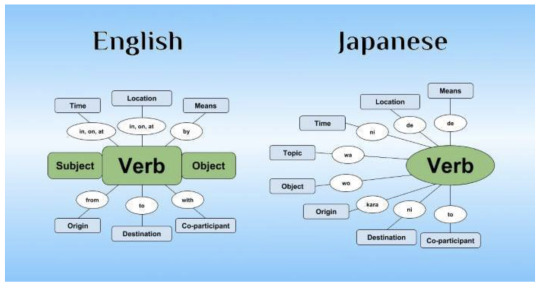
Here's the original article(元記事):Japanese Sentence Structure: The Ultimate Beginner’s Guide
助詞「と」|Particle "to"
There are several functions of the particle の(no).
助詞「の」には、いくつかの働きがあります。
・Possessor(所有者)
・Author・Creator(作者・創作者)
・Explanation(説明)
・Apposition(並列)
所有者(しょゆうしゃ)Possessor
日本人は、助詞「の」を人と物の間に挟んで持ち主を示します。日本語では、「わたし」と助詞「の」の組み合わせることで英語の「my」を意味します。英語と同じように、「わたしの」は他にも様々なものに使うことができます。また、人と助詞「の」の組み合わせは、所有を表す「〜's」のように他の人にも同様に使われます。
To indicate who owns the thing, Japanese people use the particle の(no) in between the person and the thing. The combination of "watashi" and the particle "no" means "my" in Japanese. You can use "watashi-no" with other items just like the English "my". Also, it's available for any other people in the same way as the English "〜's".

your
あなた の ペン [anata - no - pen]:your pen
you / "no" / pen
his
かれ の ペン [kare - no - pen]:his pen
he / "no" / pen
Taro's
たろう の ペン [tarou - no - pen]:Taro's pen
Taro / "no" / pen
1)This is my baggage.
kore wa watashi-no nimotsu desu.
これは、わたし の にもつ です。
this is / my baggage / *polite suffix
2)Is this your wallet?
kore wa anata-no saihu desuka?
これは、あなた の さいふ ですか?
this is / your wallet / *polite suffix
3)It's not Yuri's birthday today.
kiyou wa, Yuri-no tanjoubi janai desu
きょう は、 ゆり の たんじょうび じゃない です。
today / Yuri's birthday / not / *polite suffix
作者(さくしゃ)Author
創作者(そうさくしゃ)Creator
作曲家と曲の間に、助詞「の」が置かれています。「ショパンが作曲した曲」と言うこともできますが、それだと長くなるので、よくこのように助詞「の」を使って短く表現することがあります。
Can you see the particle "no" placed in between the composer and the song? You can also say "the song that Chopin composed" in Japanese too.
But it'll be longer and Japanese people often express shortly using the particle の(no).

1)I like Osamu Dazai's novels.
Dazai Osamu-no shou-setsu ga suki desu
だざい おさむ の しょうせつ が、すき です。
Osamu Dazai's novels / I like
2)I don't like his songs.
kare-no kiyoku ga, suki janai desu
かれ の きょく が、すき じゃない です。
his songs / I don't like
3)Who's poetry do you like ?
dare-no shi ga, suki desuka?
だれ の し が、すき ですか?
whoes poetry / do you like?
説明(せつめい)Explanation
説明を加えるときも、助詞「の」が使われます。
ルールは、説明部分がいつもメインとなる名詞の前に来ることだけです。これを守りさえすれば、一つの文章に対して助詞「の」を複数回使うこともできます。
You can use the particle "no" to add an explanation for something.
The only rule is that explanation parts are always put before the main object in Japanese. As long as you're following this rule, you can use the particle "no" more than twice just in a phrase.
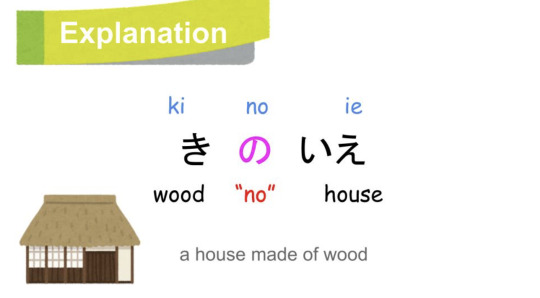
1)I watched a movie about Japanese history.
nihon-no-rekishi-no eiga o, mimashita
にほん の れきし の えいが を、みました。
Japanese history / movie / I watched
2)I have a Canadian friend.
kanadajin-no tomodachi ga, imasu
かなだジン の ともだち が います。
Canadian / friend / I have
3)Do you have a menu for vegetarian?
bejitarian-no meniyuu wa, arimasuka?
ベジタリアン の メニュー は、ありますか?
vegetarian / menu / do you have?
並列(へいれつ)Apposition
本語では、「わたしのともだち」と「ケン」を結びつけるために、間に助詞「の」が必要になります。これは、ビジネスシーンでもよく使われる表現です。
In Japanese, you need the particle "no" in-between, to establish the link between "my friend" and "Ken". It's used often in business situations too.

1)This is Mr. Nakano of Toyota motor corporation.
ochira wa, toyota-no nakano-san desu
こちらは、トヨタ の なかのさん です。
This is / Toyota / Mr. Nakano / *polite suffix
2)I'm Harada in accounting division.
keiribu-no harada to, moushimasu
けいりぶ の はらだ と、 もうします。
accounting division / Harada / my name is *modest expression
youtube
ありがとうございました!
次回は、助詞「が」と「は」を比較する予定です。
ぜひInstagramをフォローいただき、最新の投稿をご覧ください!
Thank you for reading!
Please follow me on Instagram to check my latest posts.
0 notes
Text
吉岡ひでたか* - 名物おばあちゃん = Meibutsu Obaachan (7", Promo)
吉岡ひでたか* – 名物おばあちゃん = Meibutsu Obaachan (7″, Promo)
Vinyl(VG) Sleeve(VG) / Sleeve has writing /
コンディション 盤 : Very Good (VG)
コンディション ジャケット : Very Good (VG)
コンディションの表記について [ M > M- > VG+ > VG > G+ > G > F > P ]
レーベル : Columbia – SCS-357
フォーマット : Vinyl, 7″, Promo
生産国 : Japan
発売年 : 1977
ジャンル : Children’s
スタイル :
収録曲 :
A. 名物おばあちゃん B. パパが出張から帰ったら
Illustration – Osamu Harada (2)
Made By Nippon Columbia Co., Ltd.
Data provided by Discogs
View On WordPress
0 notes
Text
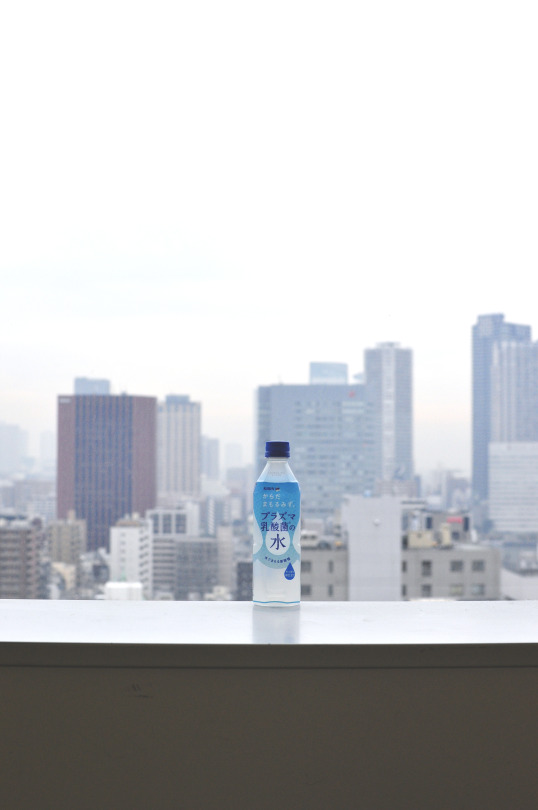

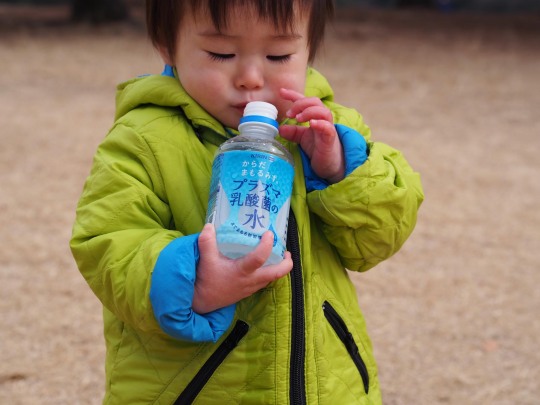

KIRIN プラズマ乳酸菌の水 2014
Art direction : Tomoko Hamada
CD : Osamu Tamura
C : Kensuke Harada
D : Noriko Takahara
0 notes
Text
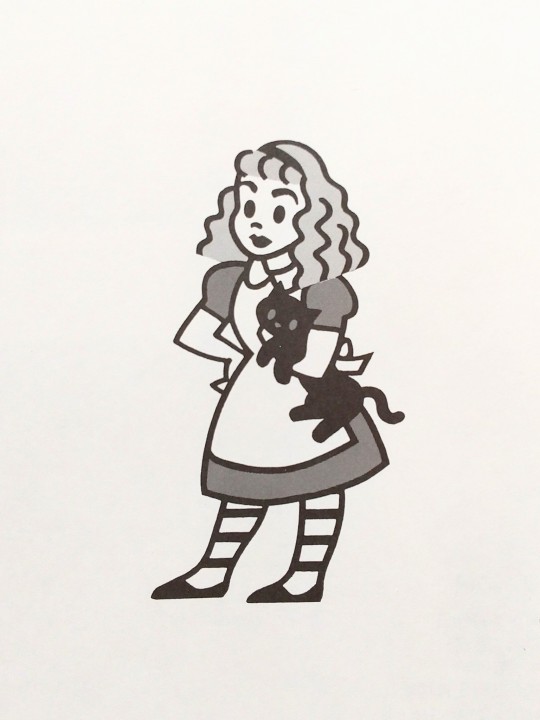
原田治 Osamu HARADA 1990
8 notes
·
View notes
Photo

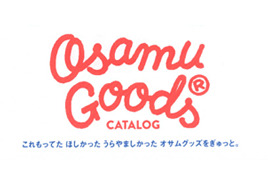




Osamu Goods
1 note
·
View note
Text

5 notes
·
View notes
Photo

幻想と怪奇 1973年11月号
ラヴクラフト=CTHULHU神話特集
歳月社
表紙構成・作品=原田治
#幻想と怪奇 1973年11月号#幻想と怪奇#lovecraft#ラヴクラフト#cthulhu mythos#CTHULHU神話#クトゥルフ神話#osamu harada#原田治#anamon#古本屋あなもん#あなもん#book cover
16 notes
·
View notes
